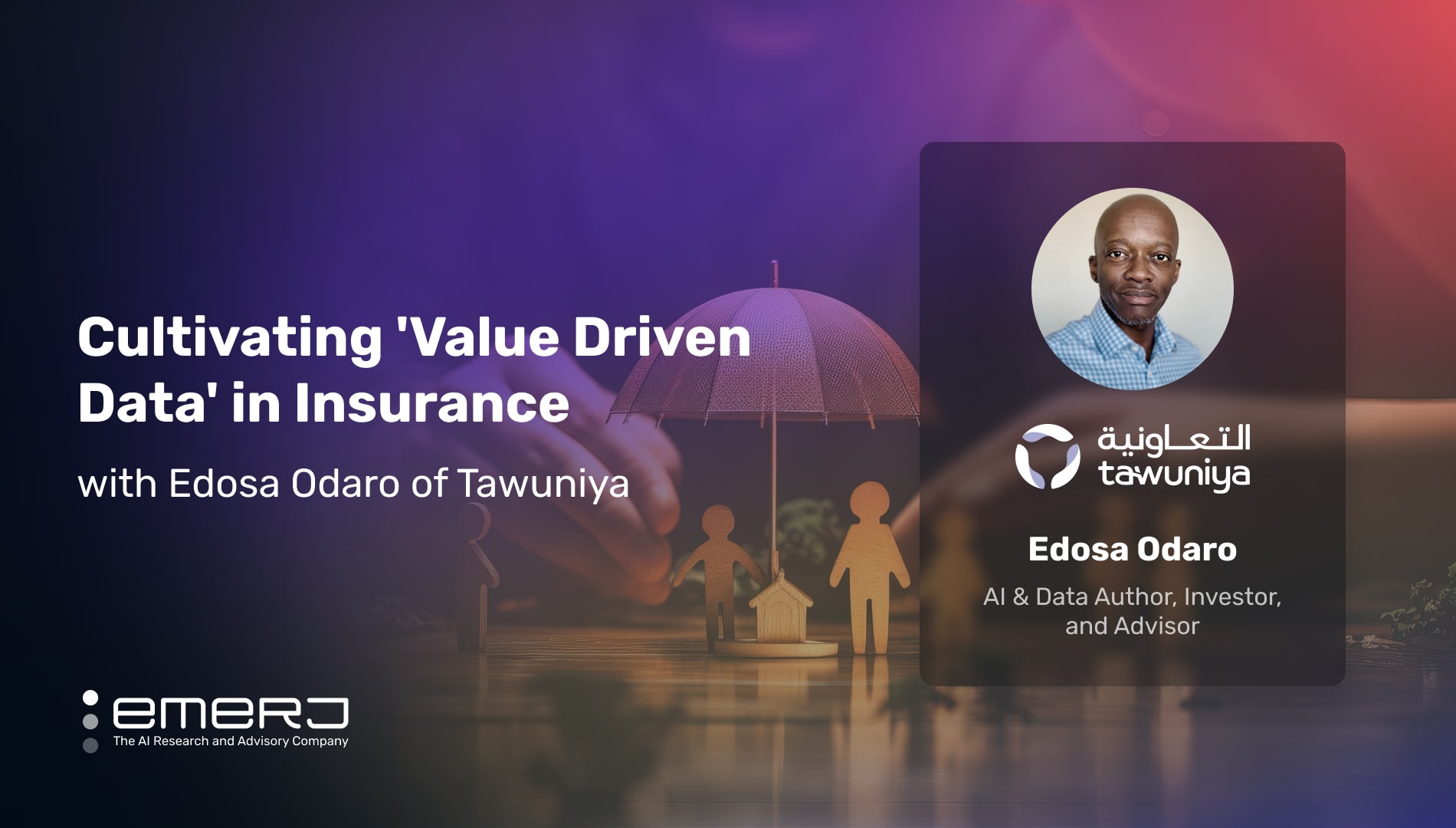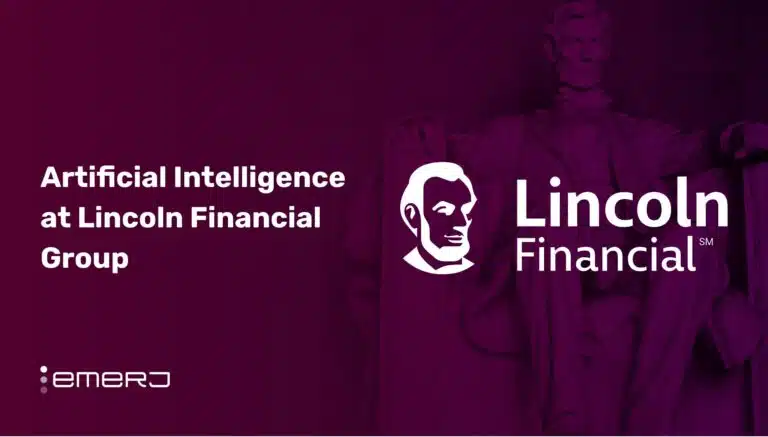Business processes are defined in large part by the data within an organization. Value-driven data, by definition, represents higher-quality data. The importance of high-quality data cannot be overlooked. Research from MIT, even from before the pandemic AI boom, showed that insufficient data can cost as much as 25% of the revenue for most companies.
Founded in 1986, Tawuniya offers its customers over 60 types of insurance products, including medical, property, and casualty insurance. Edosa Odaro is Tawuniya’s current Chief of Data Analytics and Privacy Officer and the author of two books on overcoming data challenges, Making Data Work and Value Driven Data.
Emerj Senior Editor Matthew DeMello recently sat down with Odaro on the ‘AI in Business’ podcast to talk about the two books Odaro wrote and how organizations can overcome the challenges of digital transformations.
In addition to discussing overcoming the hurdles of digital transformation, the following article will focus on two key takeaways from their conversation:
- Driving data alignment within organizations: Recognizing the role of data alignment in achieving a vision for data provides insight, discovers new options, and explores different directions to drive faster decision-making and lower risk for insurance organizations.
- Identifying creative ways to connect data silos: Understanding new scope and using a two-step process of reset and reversal to modify existing data silos.
Listen to the full episode below:
Guest: Edosa Odaro, Chief of Data Analytics and Privacy Officer, Tawuniya
Expertise: Data science, Analytics, Strategic Leadership, AI
Brief Recognition: Odaro began with Allianz Insurance in its data analysis department before transitioning to a data solutions architect consultant, a role he undertook for several well-known private and public enterprises for nearly two decades. He was the Chief Data Officer at both AXA Insurance and AIG for several years, during which time he wrote the first of his two books, Making Data Work. KoganPage published his most recent book, Value Driven Data, in August of 2023.
Driving Data Alignment within Organizations
In the beginning portion of the podcast, Edosa Odaro starts by answering what data vision means and how it engenders a perspective that’s unique from standard approaches to data governance and management.
Odaro describes the fundamentals of data vision and how it really begins with data-enabled vision. He compares data vision to how most people would think about vision in general since there are similar properties between the two. Data vision is a type of vision that provides insight, discovers new options and explores different directions.
After defining what data vision is in his view, Odaro takes this a step further and describes data-enabled vision. In-depth coverage and more details on the concept are described in his book Value Driven Data. Still, Odaro defines data-enabled vision as transcending the data and moving towards what the organization’s goal is trying to achieve.
Once the ultimate goals are established, the emphasis could return to the actual data with the intention of creating an action plan to achieve these goals.
Odaro goes on to emphasize the importance of resisting the temptation of forging too fast into the data. Again, Odaro restates the importance of finding the organization’s objectives first in order for data alignment to be achieved. Otherwise, organizations would have to deal with a misalignment issue.
Odaro then breaks down data-enabled vision into a single, fundamental issue. He describes how the organization, rather than an individual, achieves data alignment. However, most organizations will discover a copious amount of misalignment while they are trying to achieve alignment.
Odaro then states that organizations will have two choices: The first choice would be to ignore the misalignment and pretend that the misalignment is nonexistent. Alternatively, the second choice would be to confront the data misalignment.
In confronting the data misalignment head-on, Odaro offers the executive podcast audience a process called ‘triangulation’ that emphasizes leaders look at things from multiple perspectives with the intent to make the best of the situation. As he mentions in the podcast and his book, the process is called triangulation. The final step after triangulation involves bringing everything together in order to create a plan of action.
Odaro goes on to mention the challenges of filtering vision misalignment. At first glance, what appears to be a simple task of filtering, in reality, is much more complex, especially for an established industry like the insurance industry.
There is a constant struggle to introduce novel approaches to problems that are fundamentally uncomfortable for long-established workforces and workplace trends versus the ever-reliable status quo. That inherent struggle is a roadblock to innovation in the insurance industry, according to Odaro.
Odaro further clarifies, “The trouble is when you’re looking at innovation when you’re looking at things to renew and find new ways of doing things, a lot of times what you’re trying to do is do things not quite in the way they’ve always been done, and a lot of times those ideas are hidden away within misalignments.”
According to Odaro, the struggle between the novel and status quo approaches is vital to understand when organizations are trying to reinvent and innovate.
In applying these strategies to innovation and speed of processing claims in the insurance industry, Odaro states that there are two schools of thought. The first is to push harder and make quicker decisions in order to increase the speed of insurance claims. The other method, a method that potentially exposes the company to risk, is to remove steps in the insurance claim process.
To further illustrate his point, Odaro explains an insurance case study examining fraud. Every detected case of fraud requires human intervention to verify it. If incorporating new data brings in a 10-fold increase in fraud detection, a bottleneck would occur in the process if the human intervention does not also increase at a similar rate.
When asked about triangulation producing frustration, Odaro mentions that frustration is actually beneficial if its outcome leads to your objective. A lot of people will equate frustration with failure, but Odaro says there is a distinction between them. While Odaro does say that catastrophic failures should always be avoided, more minor failures provide a learning opportunity. Those types of failures are much more beneficial, and the company organization should embrace them.
Identifying Creative Ways to Connect Data Silos
Next on the podcast, Odaro mentions the pitfalls of workplace silos. However, his opinion regarding silos is a bit unorthodox and somewhat contrarian. Most people in the industry call for the immediate destruction of workplace silos. Odaro believes that instead of destroying the silos, companies should be looking for ways to connect the existing silos. He also explains that select silos could be eliminated if open communication between company divisions better fits the new scope of organizational goals.
Practically speaking, Odaro mentions that the process of silo modification involves two steps. The first step is reset; the second step is the reversal. In the reset step, the company would lay out a new scope for everyone to understand. The reset step will often run into difficulties regarding historical baggage. Decisions would need to be made on whether the baggage should be removed or incorporated into the new layout structure.
Before completing a reversal of the silo structures, Odaro mentions that rewards should be established inside the new layout. Employees would need an apparent reward for doing the correct actions. Without a reward in place, there would be a reduced chance that the new design will effectively take place.



















